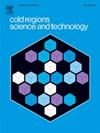A two-dimensional coupled energy-mass transfer model for simulating rain-on-snow load dynamics on roofs
IF 3.8
2区 工程技术
Q1 ENGINEERING, CIVIL
引用次数: 0
Abstract
Climate changes have led to an increase in the frequency and severity of rain-on-snow (ROS) events, risking structural safety with increasing roof snow loads. These events involve melting, freezing, and compaction induced by water infiltration in roof snowpacks. Existing models assume snow as a homogeneous medium with uniform ROS load distribution while ignoring critical phenomena like phase changes, heterogeneity, and evolution of snowpack's properties that alter water retention in snow. Although snow load is adjusted based on slope and roof geometry, these adjustments are not considered for ROS surcharge load. A two-dimensional coupled energy-mass (EM) transfer model using the Multi-point Flux Approximation method (MPFA) is employed to simulate ROS load on sloped roofs along with heat exchange, melting, refreezing, and compaction effects. Compared to simplified mass transfer models, the EM transfer model exhibits superior predictive capabilities when evaluated against experimental results. Although melting and compaction significantly increased the density, reducing porosity and permeability, the melted water accelerated saturation at the bottom boundary, enabling quicker outflow conditions. A non-uniform triangular water retention pattern at the lower roof edge was observed in both models, suggesting that heterogeneity has minimal impact on the water retention profile. Under the studied ROS load conditions, the ROS load at the roof edge is 1.6 times the overall ROS load due to non-uniform water retention. The study highlights the inadequacy of existing design code as the design ROS load is inapplicable to the studied ROS condition, despite localized loads being close to design ROS load (0.38 kN/m2).
房顶雨雪荷载动力学模拟的二维耦合能量-质量传递模型
气候变化导致雨雪(ROS)事件的频率和严重程度增加,随着屋顶雪荷载的增加,结构安全受到威胁。这些事件包括融雪、冻结和由屋顶积雪的水渗透引起的压实。现有的模型假设雪是一种均匀的介质,具有均匀的ROS负荷分布,而忽略了相变、非均质性和积雪性质演变等改变雪中保水能力的关键现象。虽然雪荷载根据斜坡和屋顶几何形状进行调整,但这些调整不考虑ROS附加荷载。采用多点通量近似法(MPFA)建立了二维能量-质量耦合传递模型,模拟了斜坡屋顶上的活性氧负荷以及热交换、熔化、再冻结和压实效应。与简化的传质模型相比,电磁传质模型在与实验结果对比时显示出更好的预测能力。虽然熔融和压实显著增加了密度,降低了孔隙度和渗透率,但融化的水加速了底部边界的饱和,使流出条件更快。在两种模型中都观察到下顶板边缘的非均匀三角形保水模式,这表明非均匀性对保水剖面的影响很小。在所研究的ROS荷载条件下,由于不均匀持水,顶板边缘的ROS荷载为总ROS荷载的1.6倍。尽管局部荷载接近设计ROS荷载(0.38 kN/m2),但设计ROS荷载并不适用于所研究的ROS工况,突出了现有设计规范的不足之处。
本文章由计算机程序翻译,如有差异,请以英文原文为准。
求助全文
约1分钟内获得全文
求助全文
来源期刊

Cold Regions Science and Technology
工程技术-地球科学综合
CiteScore
7.40
自引率
12.20%
发文量
209
审稿时长
4.9 months
期刊介绍:
Cold Regions Science and Technology is an international journal dealing with the science and technical problems of cold environments in both the polar regions and more temperate locations. It includes fundamental aspects of cryospheric sciences which have applications for cold regions problems as well as engineering topics which relate to the cryosphere.
Emphasis is given to applied science with broad coverage of the physical and mechanical aspects of ice (including glaciers and sea ice), snow and snow avalanches, ice-water systems, ice-bonded soils and permafrost.
Relevant aspects of Earth science, materials science, offshore and river ice engineering are also of primary interest. These include icing of ships and structures as well as trafficability in cold environments. Technological advances for cold regions in research, development, and engineering practice are relevant to the journal. Theoretical papers must include a detailed discussion of the potential application of the theory to address cold regions problems. The journal serves a wide range of specialists, providing a medium for interdisciplinary communication and a convenient source of reference.
 求助内容:
求助内容: 应助结果提醒方式:
应助结果提醒方式:


